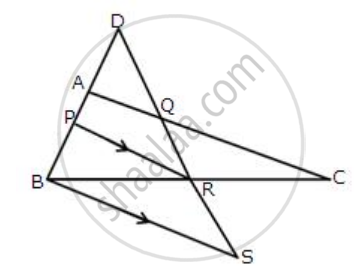Advertisements
Advertisements
प्रश्न
In the given figure, `square`PQRS and `square`MNRL are rectangles. If point M is the midpoint of side PR then prove that,
- SL = LR
- LN = `1/2`SQ

उत्तर
(i) `square`LMNR and `square`MNRL are rectangles.
∴ Side LM || Side RN ...(Opposite sides of rectangle)
That is, Side LM || Side RQ ...(R-N-Q) ...(i)
Side RQ || Side SP ...(Opposite sides of the rectangle) ...(ii)
From (i) and (ii),
Side LM || Side SP ...(iii)
In ΔRSP,
Point M is the midpoint of Seg PR.
Line LM || Line SP ...[From (iii)]
∴ Point L is the midpoint of Seg SR. ...(Converse of Midpoint Theorem) ...(iv)
∴ SL = LR
(ii) The diagonals of a rectangle are congruent.
∴ SQ = PR ...(v)
LN = MR ...(vi)
Now, MR = `1/2` PR ...(Point M is the midpoint of line PR.) ...(vii)
∴ LN = `1/2` PR ...[From (vi) and (vii)] ...(viii)
∴ LN = `1/2` SQ ...[From (vii) and (viii)]
APPEARS IN
संबंधित प्रश्न
ABC is a triang D is a point on AB such that AD = `1/4` AB and E is a point on AC such that AE = `1/4` AC. Prove that DE = `1/4` BC.
The diagonals of a quadrilateral intersect at right angles. Prove that the figure obtained by joining the mid-points of the adjacent sides of the quadrilateral is rectangle.
In triangle ABC, AD is the median and DE, drawn parallel to side BA, meets AC at point E.
Show that BE is also a median.
In a triangle ABC, AD is a median and E is mid-point of median AD. A line through B and E meets AC at point F.
Prove that: AC = 3AF.
In the figure, give below, 2AD = AB, P is mid-point of AB, Q is mid-point of DR and PR // BS. Prove that:
(i) AQ // BS
(ii) DS = 3 Rs.

In trapezium ABCD, sides AB and DC are parallel to each other. E is mid-point of AD and F is mid-point of BC.
Prove that: AB + DC = 2EF.
In ΔABC, D, E, F are the midpoints of BC, CA and AB respectively. Find FE, if BC = 14 cm
Side AC of a ABC is produced to point E so that CE = `(1)/(2)"AC"`. D is the mid-point of BC and ED produced meets AB at F. Lines through D and C are drawn parallel to AB which meets AC at point P and EF at point R respectively. Prove that: 4CR = AB.
ABCD is a parallelogram.E is the mid-point of CD and P is a point on AC such that PC = `(1)/(4)"AC"`. EP produced meets BC at F. Prove that: F is the mid-point of BC.
In ∆ABC, AB = 5 cm, BC = 8 cm and CA = 7 cm. If D and E are respectively the mid-points of AB and BC, determine the length of DE.
